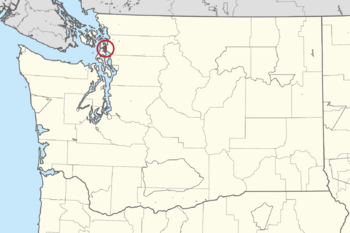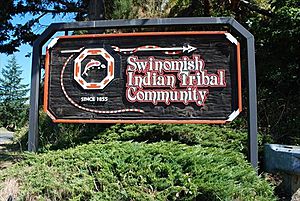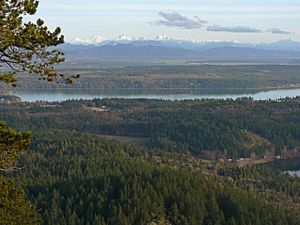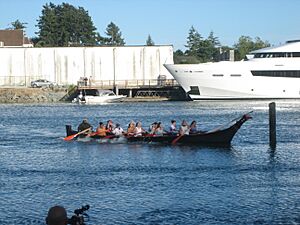Swinomish Indian Tribal Community facts for kids
Quick facts for kids
Swinomish Indian Tribal Community
|
|
|---|---|
|
Flag
|
|

Location of the Swinomish Tribe
|
|
| Tribal headquarters | 1404 Moorage Way, La Conner, WA 98257 |
| Largest settlement | Swinomish Village |
| Demonym(s) | Swinomish |
| Enrolled members | 1,439 |
| Government | Federally recognized tribe |
|
• Chair
|
Steve Edwards |
|
• Vice-chair
|
Alana Quintasket |
|
• Secretary
|
Brian Porter |
| Legislature | Swinomish Senate |
| Domestic dependent nation | |
|
• Treaty
|
Treaty of Point Elliot (1855) |
|
• Constitution
|
January 27, 1936 |
The Swinomish Indian Tribal Community, also known as the Swinomish Tribe, is a federally recognized tribe. This means the United States government officially recognizes them as a Native American nation. They are located on Puget Sound in Washington state.
The Swinomish Tribe is made up of the descendants of people who signed the 1855 Treaty of Point Elliott. Their Reservation is about 65 miles north of Seattle, Washington, on Fidalgo Island. The tribe includes people from the Swinomish, Lower Skagit, Kikiallus, and Samish groups. Other people living on the reservation include the Suquamish and Upper Skagit.
Contents
History of the Swinomish Tribe
The Swinomish Tribe comes from several Native American groups. These include the Swinomish, Samish, Kikiallus, and Lower Skagit peoples. Their ancestors lived in the Skagit and Samish river valleys. They also lived on nearby islands like Fidalgo, Whidbey, Camano, and the San Juan islands.
In 1855, these groups met at Point Elliott with many other tribes. They signed the Treaty of Point Elliott. This treaty created the Swinomish Reservation for the tribes in the area.
In 1873, President Ulysses S. Grant tried to change the reservation's western border. This would have removed March Point and other areas. However, the United States Supreme Court has said that only Congress can change a reservation's size. The Swinomish Tribe still believes these lands belong to them, as shown in the original treaty maps.
In 1971, the Indian Claims Commission did not agree to change the reservation's borders. The Swinomish Tribe wanted the western boundary restored as promised. In 1972, the Commission gave the Swinomish Tribe $29,000. This was because the United States had paid too little for the land the tribe gave up.
In 2008, the Tribe made a film called March Point. It showed three Swinomish teenagers looking into how oil refineries affected their lands. These refineries are the Puget Sound Refinery and the Marathon Anacortes Refinery.
Lawsuit Against BNSF Railway
In 2012, the Swinomish Tribe learned that very long trains were crossing their Reservation. These trains, called "unit trains," had 100 or more railcars. By 2015, the BNSF Railway was running six such trains each week. This was much more than allowed by an agreement they had with the Tribe.
The Tribe had an agreement, called an easement, with the railway. This agreement limited the number of trains and cars. It was important for the Tribe's plans to build an economic center.
In April 2015, the Tribe sued BNSF Railway. A court in Seattle ruled that BNSF had broken the agreement. BNSF had not told the Tribe about the extra trains or gotten their permission. BNSF argued that its duties to its customers were more important. But in 2020, a higher court disagreed with BNSF.
In 2022, the court decided that BNSF's actions were intentional. A trial in 2023 looked at whether BNSF knew they were trespassing. The court found that BNSF's trespass was "willful, conscious, and knowing." This meant the Tribe could ask for money BNSF made unfairly.
On June 6, 2024, Judge Robert S. Lasnik ordered BNSF to pay the Swinomish Tribe. BNSF had to pay $394,517,169. This money was for the profits BNSF made by trespassing on the Reservation.
Swinomish Reservation Lands
The Swinomish Indian Reservation is the official land of the Swinomish Indian Tribal Community. It is located on Puget Sound, on the southeastern side of Fidalgo Island in Skagit County, Washington. The reservation is next to the Swinomish Channel, across from La Conner, Washington.
The reservation was created in 1855 by the Treaty of Point Elliott. Today, it is about 15 square miles (39 km2; 9,600 acres) in size. However, the Swinomish Tribe believes its true borders are larger. In 2020, 3,228 people lived on the reservation, including tribal members and others.
A railway line was built across the reservation in 1889 without the Tribe's permission. Today, BNSF Railway operates this line. An agreement from 1991 allows only two trains per day, each with 25 cars or less. In 2023, a BNSF train derailed on the reservation, spilling 3,100 gallons of diesel fuel.
Important places on the Swinomish Reservation include:
- Swadabs Park, on Swinomish Channel: This park has three shelters that look like woven cedar hats. It also has information panels and a garden with native plants. The park was built for the 2011 Canoe Journey/Paddle to Swinomish. Canoe races are also held here.
- Kukutali Preserve: This is the first Tribal State Park in the United States. It is owned and managed together by a Native American nation and a state government. The preserve is entirely on the Swinomish Reservation. It covers 83 acres (34 ha) across three islands. It has over two miles (3.2 km) of natural shoreline. It is also next to 38 acres (15 ha) of Swinomish-owned tidelands.
Swinomish Population
The Swinomish Tribe has 1,439 enrolled members. Most of these members live in the community of Swinomish Village on the reservation. Many other members live off the reservation in nearby Skagit County.
| Year | Number |
|---|---|
| 1909 | 268 |
| 1937 | 285 |
| 1985 | 624 |
| 2002 | 778 |
| c. 2024 | 1,439 |
Most people in the community are Catholic.
Swinomish Culture and Traditions
English is the main language spoken by Swinomish citizens. Some elders still speak Swinomish. This language is also called Skagit. It is a dialect of the Lushootseed language, which is part of the Coast Salish language family. Some also spoke Samish, another Coast Salish language.
The Swinomish people traditionally grew clams in special areas called clam gardens. They are now bringing back this practice to help with climate resilience. Global warming and its effects, like ocean acidification, harm the shells of sea animals. These animals are important for the Swinomish food supply. The Swinomish see the health of their traditional foods as a sign of climate change. In 2022, the Swinomish built the first traditional clam garden in the United States in 200 years. This garden is at Kiket Island. Clam gardens can produce four times more clams than regular beaches.
The Swinomish hold the annual Swinomish Festival on Memorial Day. This festival includes traditional stick-and-ball games, dancing, and a salmon bake. The tribe also celebrates the annual Treaty Days Celebration around January 22. They also have the traditional First Salmon Ceremony each year. This ceremony celebrates the start of the fishing season and protects the community's fishermen.
Economy and Services
Many tribal members rely on salmon fishing and shellfish harvesting for their living. They have had disagreements with the government over fishing rights for many years. Their salmon catches have dropped by over 80% in the last 20 years. This is due to very high temperatures in the Skagit River. In February 2024, the Swinomish Tribe announced plans to sue the EPA. They believe the EPA has not done enough to lower river temperatures.
The Swinomish Tribe is one of the five largest employers in Skagit County. They have over 350 employees in their tribal government. They also have about 600 employees in their casino and other businesses.
The tribe provides education, childcare, and health services. The Swinomish Tribe built a 1,375 square feet (127.7 m2) healthcare center, called the Swinomish Tribal Health Center.
The tribe is part of the Skagit River Cooperative, formed in 1976. This group works to manage and improve fishing in the Skagit River. The Swinomish Tribe also belongs to the Northwest Indian Fisheries Commission. This group helps 20 treaty Indian tribes in western Washington. It was created after a 1974 court ruling. This ruling confirmed the tribes' treaty rights to fish. It also recognized tribes as co-managers of natural resources with Washington State. They share equally in the number of salmon caught each year.
Notable Swinomish Citizens
- Brian Cladoosby, a former chairman of the Swinomish Tribe. He was also the 21st president of the National Congress of American Indians.
- Lorraine Loomis (1940-2021), a former chair of the Northwest Indian Fisheries Commission and a Swinomish Tribe senator.






